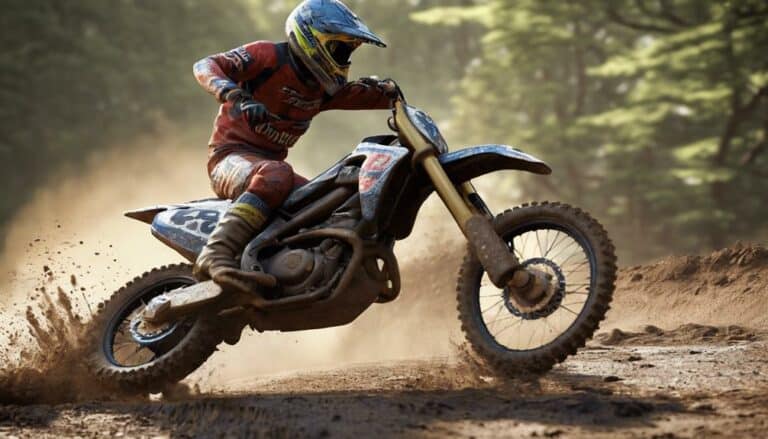When it comes to effective braking on a dirt bike, weight distribution is paramount. Properly positioning your weight between the front and rear wheels can greatly impact your braking performance.
But, have you ever wondered just how important this balance truly is? Stay tuned to discover the intricate connection between weight distribution and achieving best braking control on challenging terrain.
Key Takeaways
- Proper weight distribution is crucial for optimizing braking performance on a dirt bike.
- Balanced weight distribution enhances traction, stability, and control during braking.
- Shifting weight forward increases grip and reduces stopping distances effectively.
- Mastering weight transfer dynamics is essential for achieving efficient braking on different terrains.
Understanding Weight Distribution for Braking
When braking on a dirt bike, understanding how weight distribution affects stability and control is important for best performance. Especially when you jump hard, the way you distribute your weight can mean the difference between a smooth landing and a bumpy ride. Shifting your weight towards the front wheel before braking increases traction, allowing for more effective stopping power. This forward weight bias prevents the rear wheel from lifting off the ground, keeping the bike stable during deceleration.
On the contrary, if you lean back too much while braking, especially on loose terrain, you risk the front wheel washing out and losing control. Maintaining a balanced weight distribution is essential to prevent the bike from sliding out or veering off course unexpectedly. By mastering the art of weight transfer dynamics, you can optimize your braking performance in various riding conditions, ensuring a safe and exhilarating experience every time you hit the trails.
Impact of Weight on Braking Efficiency
Maximizing braking efficiency on a dirt bike hinges on the strategic distribution of weight to optimize traction and stability during deceleration. Weight transfer dynamics play a critical role in enhancing braking force optimization. By shifting your weight slightly forward, especially on the front wheel, you increase the pressure on the tire, improving grip and reducing the likelihood of skidding. This adjustment is particularly essential on loose or slippery surfaces, where maintaining control is challenging.
Leaning back slightly while braking helps prevent the front wheel from locking up, ensuring steering control is maintained. Additionally, considering cornering stability is important when redistributing weight during braking. Properly adjusting weight distribution based on terrain conditions can have a significant impact on braking efficiency, reducing stopping distances and enhancing overall control.
Techniques for Proper Weight Distribution
To achieve peak braking performance on a dirt bike, mastering techniques for proper weight distribution is essential. Body positioning plays a vital role in maintaining stability and control during braking. By transferring weight towards the front wheel, you can increase traction and prevent the rear wheel from skidding. Balancing weight between the front and rear wheels is key to optimizing braking efficiency and overall stability on varying terrains.
Understanding how to adjust your body position to lower the center of gravity can greatly enhance braking performance. This adjustment helps in modulating braking force according to different conditions and speeds you may encounter while riding. The front wheel, being pivotal for traction, benefits greatly from having more weight distributed towards it. By leaning forward and applying pressure on the handlebars, you can effectively manage weight transfer and improve control over your dirt bike's braking capabilities. Mastering these weight distribution techniques will certainly elevate your riding experience and safety on the trails.
Common Mistakes in Weight Placement
Avoid placing excessive weight solely on the front wheel during braking as it can result in loss of traction and potential instability. Front heavy braking can lead to the front wheel washing out, causing rear end instability and compromising control.
Overcompensating weight towards the front can disrupt the balance needed for effective braking on a dirt bike. It's essential to distribute your weight evenly between the front and rear wheels to maintain stability and control while braking.
Leaning too far back can reduce front wheel traction, affecting the bike's ability to stop efficiently. By avoiding the common mistake of front heavy braking, you can prevent potential accidents and maintain optimum braking performance.
Improving Braking Performance Through Balance
Enhance your dirt bike's braking performance by maintaining a balanced weight distribution between the front and rear wheels. To improve braking performance through balance, consider the following:
- Body Positioning: Center your body weight over the bike's center of gravity to enhance control and stability during braking maneuvers.
- Braking Technique: Lean back slightly while braking to prevent front wheel skidding and maintain traction for effective stopping power.
- Weight Transfer: Practice maintaining a balanced posture to facilitate quick weight shifts between the front and rear wheels, enabling smoother braking changes.
Conclusion
To sum up, mastering weight distribution is essential for achieving effective braking on a dirt bike.
While some may argue that it's difficult to consistently maintain proper weight placement, practice and technique can help overcome this challenge.
By understanding the impact of weight on braking efficiency and implementing proper techniques, riders can greatly improve their control, traction, and overall safety while riding.
Don't underestimate the power of weight distribution in maximizing your dirt bike's braking performance.

